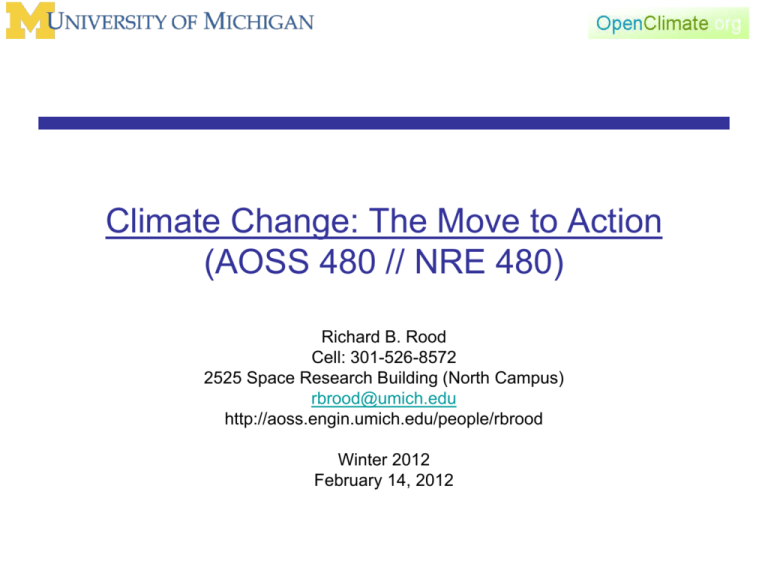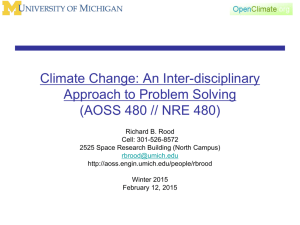AOSS_NRE_480_L11_Attribution_20120214
advertisement

Climate Change: The Move to Action (AOSS 480 // NRE 480) Richard B. Rood Cell: 301-526-8572 2525 Space Research Building (North Campus) rbrood@umich.edu http://aoss.engin.umich.edu/people/rbrood Winter 2012 February 14, 2012 Class News • Ctools site: AOSS_SNRE_480_001_W12 • 2008 and 2010 Class On Line: – http://climateknowledge.org/classes/index.php /Climate_Change:_The_Move_to_Action Some Uncertainty References • Climate Change Science Program, Synthesis Assessment Report, Uncertainty Best Practices Communicating, 2009 • Climate Change Science Program, Synthesis Assessment Report, Transportation Gulf Coast, 2008 • Moss and Schneider, Uncertainty Reporting, 2000 • Pidgeon and Fischhoff, Communicating Uncertainty, 2011 • Lemos and Rood, Uncertainty Fallacy, 2010 The Current Climate (Released Monthly) • Climate Monitoring at National Climatic Data Center. – http://www.ncdc.noaa.gov/oa/ncdc.html • State of the Climate: Global • Plant Hardiness - 2012 Today • Observations of Ecosystems • Attribution (3 ways?) Question • Madden and Ramanathan Predicted in 1980 would be discernable in 2000. • What would you do to evaluate the theory and predictions of global warming? – Surface of planet will warm – Sea level will rise – Weather will change • Think about • • • • Measurements Feedbacks Correlative behavior Impacts Signal to Noise From Leeds X-ray Imaging Signal to Noise (perhaps more like climate) From social research methods .net Signal to Noise (another example) Noise Signal Signal / Noise Ratio From astronomy and astrophysics .org Some signal to noise issues • We have many sources of variability – Sun, volcanoes, etc. – El Nino, La Nina, etc. – Ice ages, Little Ice Age, Warm Periods, etc. – Land use changes, natural carbon dioxide variability, etc. – How do we detect a trend in temperature and attribute it to human released carbon dioxide? Let’s go back to the physical climate Correlated behavior of different parameters Fig. 2.5. (State of Climate 2009) Time series from a range of indicators that would be expected to correlate strongly with the surface record. Note that stratospheric cooling is an expected consequence of greenhouse gas increases. A version of this figure with full references is available at www.ncdc.noaa.gov/bams-state-of-climate/ . Today • Observations of Ecosystems • Attribution (3 ways?) Edges • “Edges” are places where we really might be able to see things definitively. What are the edges? – Ice (Phase transition) – Deserts – Seasons There is an accumulation of observations • Physical and biological impacts correlated with temperature increase and dryer conditions. – What is the relationship between warming and surface dryness? – Strongly correlated with population and where we have looked. Project Budburst • A community science activity collect observations of the onset of spring – Project Budburst • How to observe the onset of spring – National Phenology Network Project of Trees • A community science activity to collect observations on types of trees – Canadian Plant Hardiness Site • Paper (including yours truly) on how foresters think about climate change • McKenney et al. (2011) Interestingly significant news story Hardiness Map • Arbor Day Foundation Maps of Hardiness Zones • Plant Hardiness - 2012 Can we get a global perspective from satellites? • NDVI: Normalized Difference Vegetation Index – Looks at radiative budgets, measurements, and the absorption of photosynthetically active radiation, relative to the rest of the radiation. How would these changes be revealed? Changes in vegetation activity can be characterized through 1. changes in growing season 2. changes in “productivity” Increases in growing season delayed fall earlier spring Jan Jul Aug NDVI Dec Increases in Productiviy Increase Jan Jul Aug NDVI From Compton J. Tucker, NASA Goddard Dec From Kirsten de Beures Length of Growing Season From Ranga B. Myneni, Boston University Changes in the Amplitude of the Keeling Curve (Keeling et al, 1996) Amplitude has increased 40% in Alaska, Canada Amplitude has increased 20% in Hawaii The phase, start of the decrease, start of the growing season, has moved forward 7 days. Geographical extent of warming Osborn Spatial Extent of Warming Coherent and Convergent? • There is evidence in both the physical climate system and ecosystems of systematic global warming. • This evidence shows correlated behavior through many systems. • Taken independently each piece could be challenged. • Taken together the evidence converges. – Consistent with human-related forcing Coherent and Convergent? • Taken independently each piece could be challenged. • Taken together the evidence converges. – Consistent with human-related forcing • Consistent with human-related forcing – Really? Today • Observations of Ecosystems • Attribution (3 ways?) – Fingerprinting – Joint Attribution (end-to-end method) – Event attribution Attribution • The physical climate and ecological observations in the previous are consistent with the planet is warming. • How do we decide that this is consistent with human-induced warming? Natural mechanisms influence climate Natural mechanisms • Changes in the Sun • Changes in the amount of volcanic dust in the atmosphere • Internal variability of the coupled atmosphere and ocean Thanks to Ben Santer for Content! Thanks to Ben Santer for Content! Human factors also influence climate Non-natural mechanisms • Changes in atmospheric concentrations of greenhouse gases • Changes in aerosol particles from burning fossil fuels and biomass • Changes in the reflectivity (albedo) of the Earth’s surface Smoke from fires in Guatemala and Mexico (May 14, 1998) Recent changes in carbon dioxide are largely human-induced Carbon dioxide is the most important greenhouse gas produced by human activities Atmospheric CO2 has increased from a preindustrial value of about 280 parts per million (ppm) to 379 390 ppm in 2005 2010 The atmospheric concentration of CO2 in 2010 exceeds by far the natural range (180 to 300 ppm) over the last 650,000 years Fossil fuel use is the primary source of the increased concentration of CO2 since the preindustrial period Thanks to Ben Santer for Content! Source: IPCC AR4 (2007) Thanks to Ben Santer for Content! Multiple lines of evidence on which “discernible human influence” conclusions are based 1. “Basic physics” evidence – Physical understanding of the climate system and the heat-trapping properties of greenhouse gases 2. Circumstantial evidence – Qualitative agreement between observed climate changes and model predictions of human-caused climate changes (warming of oceans, land surface, and troposphere, stratospheric cooling, water vapor increases, etc.) 3. Paleoclimate evidence – Temperature reconstructions enable us to place the warming of the 20th century in a longer-term context 4. Fingerprint evidence – Rigorous statistical comparisons between modeled and observed patterns of climate change Average surface temperature change (°C) Models can perform the “control experiment” that we can’t do in the real world Meehl et al., J. Climate (2004) What is “climate fingerprinting”? • Strategy: Search for a computer model-predicted pattern of climate change (the “fingerprint”) in observed climate records • Assumption: Each factor that influences climate has a different characteristic signature in climate records • Method: • Advantage: Fingerprinting allows researchers to make rigorous tests of competing hypotheses regarding the causes of recent climate change Standard signal processing techniques Thanks to Ben Santer for Content! IPCC Temperature Observations Note: It gets smoother away from the surface. Different factors that influence climate have different “fingerprints” 10 24 20 50 20 10 0 16 10 0 16 20 0 12 20 0 12 8 50 0 70 0 10 00 90 N 4 60 N - 1 .2 Pressure (hPa) 30 N -1 10 Eq - 0 .6 - 0 .8 - 0 .2 30 S 0. 2 - 0 .4 0 60 S 0. 6 0. 4 90 S 1 0. 8 50 10 0 20 0 30 0 60 N 30 N -1 - 1 .2 - 0 .6 - 0 .8 Eq - 0 .2 - 0 .4 30 S 0. 2 0 60 S 0. 6 0. 4 Pressure (hPa) - 0 .4 30 S 0. 2 0 60 S 0. 6 0. 4 0. 8 1. 2 28 24 20 16 12 20 0 12 30 0 8 50 0 70 0 10 0 0 90 N 4 60 N -1 - 1 .2 28 30 N Eq - 0 .6 - 0 .8 - 0 .2 30 S 0. 2 - 0 .4 0 60 S 0. 6 0. 4 90 S 1 0. 8 1. 2 28 24 25 50 20 50 20 10 0 16 10 0 16 20 0 12 20 0 12 8 30 0 30 0 50 0 70 0 10 00 90 N 4 60 N -1 - 1 .2 30 N - 0 .6 - 0 .8 Eq - 0 .2 - 0 .4 30 S 0. 2 0 60 S 0. 6 0. 4 90 S 24 8 50 0 70 0 10 00 90 N 4 60 N 1 0. 8 -1 1. 2 6. 1st five factors combined 90 S 1 25 10 1. 2 - 0 .8 Eq - 0 .2 10 0 90 S 25 Santer et al., CCSP, 2007 - 1 .2 30 N - 0 .6 16 1 0. 8 60 N -1 20 4 4. Ozone 4 50 8 2. Volcanoes 8 50 0 70 0 10 00 90 N 28 24 10 30 0 10 1. 2 25 50 0 70 0 10 0 0 90 N 5. Sulfate aerosol particles 24 50 30 0 3. Well-mixed greenhouse gases 28 25 Height (km) 25 Height (km) 1. Solar Pressure (hPa) 28 Height (km) 10 - 1 .2 30 N - 0 .6 - 0 .8 Eq - 0 .2 - 0 .4 30 S 0. 2 0 60 S 0. 6 0. 4 90 S 1 0. 8 1. 2 °C/century “Fingerprinting” with temperature changes in Earth’s atmosphere Model Changes: CO2 + Sulfate Aerosols + Stratospheric Ozone 18 100 14 200 10 300 Height (km) Pressure (hPa) 50 6 500 2 850 60N 45N 30N 15N 0 15S 30S 45S 60S Observed Changes 50 100 14 200 10 300 6 500 2 850 60N 45N 30N -1. 5 -1. 8 Santer et al., Nature (1996) Height (km) Pressure (hPa) 18 15N -0. 9 -1. 2 0 -0. 3 -0. 6 15S 0. 3 0 30S 45S 0. 9 0. 6 60S 1. 5 1. 2 1. 8 Temperature changes in oC Searching for fingerprints of human activities in the world’s oceans • Initial work by Syd Levitus and colleagues showed an increase in the heat content of the oceans over the second half of the 20th century (Levitus et al., 2001, Science) • Subsequent research by Tim Barnett and colleagues identified a human fingerprint in the observed ocean heat content changes (Barnett et al., 2001, Science) Thanks to Ben Santer for Content! “Fingerprinting” in the ocean: Warming of the North Atlantic over 1955-99 Thanks to Ben Santer for Content! Barnett et al., Science (2005) “Fingerprinting” in the ocean: Warming of the world’s oceans over 1955-99 Thanks to Ben Santer for Content! Barnett et al., Science (2005) Fingerprint detection explained pictorially…. Thanks to Ben Santer for Content! Time-varying observed patterns MO D E L : P C M E O F : 1 E X P T :control B 0 0 4 . 1 0 - c n t r l Erun V : 27.40% N T : 3 0 0 MO N T H S Time-varying patterns D i m e n s 2i o9 n/ 0l e3s/ 0s 4 1 6 : 3 2 : 2 6 MO D E L : P C M E O F : 1 E X P T : B 0 0 4 . 1 0 - c n t r l E V : 2 7 . 4 0 % N T : 3 0 0 MO N T H S D i m e n s 2i o9 n/ 0l e3s/ 0s 4 1 6 : 3 2 : 2 6 E X P T : B 0 0 4 . 1 0 - c n t r l E V : 2 7 . 4 0 % N T : 3 0 0 MO N T H S D i m e n s 2i o9 n/ 0l e3s/ 0s 4 1 6 : 3 2 : 2 6 MO D E L : P C M E O F : 1 E X P T : B 0 0 4 . 1 0 - c n t r l E V : 2 7 . 4 0 % N T : 3 0 0 MO N T H S D i m e n s 2i o9 n/ 0l e3s/ 0s 4 1 6 : 3 2 : 2 6 MO D E L : P C M E O F : 1 E X P T : B 0 0 4 . 1 0 - c n t r l E V : 2 7 . 4 0 % N T : 3 0 0 MO N T H S D i m e n s 2i o9 n/ 0l e3s/ 0s 4 1 6 : 3 2 : 2 6 MO D E L : P C M E O F : 1 t=1 t=2 t=3 t=4 t=n -1 -0 . 6 - 1- 0 . 8 -1 . 2 -0 . 2 - 0 .-60 . 4 - 1- 0 . 8 -1 . 2 - 0 .-60 . 4 - 1- 0 . 8 -1 . 2 -1 . 2 0.6 0 . 20 . 4 - 0 . 20 - 0 .-60 . 4 - 1- 0 . 8 -1 . 2 0.2 - 0 . 20 -0 . 8 0 . 20 . 4 Projection onto model fingerprint 0 . 60 . 8 11.2 0 . 60 . 8 0 . 20 . 4 0 Model fingerprint -1 . 5 11.2 0 . 20 . 4 - 0 . 20 -0 . 4 1 0 . 60 . 8 - 0 . 20 - 0 .-60 . 4 t=1 t=2 t=3 t=4 t=n -1 . 2 5 0 . 60 . 8 0.4 0.8 -1 . 5 1.2 Signal and noise time series 1 . 215. 5 0 . 7 51 0 . 205. 5 - 0 . 2 05 -0 . 5 1.25 0 . 7 51 0 . 205. 5 - 0 . 2 05 - 0 . 7- 05. 5 -1 0.75 0 . 205. 5 - 0 . 2 05 - 0 . 7- 05. 5 - 1 . 2 -51 -1 . 5 0.25 - 0 . 2 05 - 0 . 7- 05. 5 - 1 . 2 -51 -1 . 5 11.2 -0 . 2 5 - 0 . 7- 05. 5 - 1 . 2 -51 -1 . 5 11.2 -0 . 7 5 - 1 . 2 -51 0 . 205. 5 0 1 . 215. 5 0 . 7 51 1 . 215. 5 0 . 7 51 0.5 1 . 215. 5 1 .5 Projection 1onto model fingerprint Signal-to-noise ratios -1 -1 . 2 -0 . 6 -0 . 8 -0 . 2 -0 . 4 0.2 0 0.6 0.4 1 0.8 1.2 Human-caused fingerprints have been identified in many different aspects of the climate system Thanks to Ben Santer for Content! Surface specific humidity Water vapor over oceans Tropospheric temperatures -0 . 5 -0 . 6 Ocean temperatures -0 . 3 -0 . 4 -0 . 1 -0 . 2 0.1 0 0.3 0.2 Stratospheric temperatures 0.5 0.4 -1 -0 . 6 -0 . 2 Tropopause height 0.6 -1 . 2 -0 . 8 -0 . 4 0.2 0 0.6 0.4 Sea-level pressure Atmospheric temperature 50 18 100 14 200 Zonal-mean rainfall Near-surface temperature 10 300 6 500 2 850 60N 45N 30N -1. 5 -1. 8 15N -0. 9 -1. 2 0 -0. 3 -0. 6 15S 0. 3 0 30S 45S 0. 9 0. 6 Continental runoff 60S 1. 5 1. 2 1. 8 1 0.8 1.2 Key results of IPCC AR4: We are now able to identify human influences on climate at continental scales Continental warming likely shows a significant anthropogenic contribution over the past 50 years Thanks to Ben Santer for Content! Today • Observations of Ecosystems • Attribution (3 ways?) – Fingerprinting – Joint Attribution (end-to-end method) • Rosenzweig et al., Nature, 2008 – Event attribution Global distribution of changes sensitive to temperature IPCC Technical Summary WG2 Summary from Rosenzweig et al., Nature, 2008 • • • • • shrinking glaciers in every continent melting permafrost shifts in the spring peak of river discharge associated with earlier snowmelt lake and river warming with effects on thermal stratification, chemistry and freshwater organisms increases in coastal erosion • • shifts in spring events (for example, leaf unfolding, blooming date, migration and time of reproduction), species distributions and community structure demonstrated changes in marineecosystem functioning and productivity, including shifts from cold-adapted to warm adapted communities, phenological changes and alterations in species interactions Joint attribution • What would you do to evaluate the theory and predictions of global warming? – Surface of planet will warm – Sea level will rise – Weather will change • Think about • • • • Measurements Feedbacks Correlative behavior Impacts • Joint Attribution • Documented statistical analysis • Process-level understanding Joint attribution • Joint Attribution – Documented statistical analysis – Process-level understanding • Look to see for biological systems – Unlikely due entirely to natural variability – Consistent with estimated responses of physical or biological variables – Non consistent with alternative, plausible explanations • That are in regions where physical variables, esp. temperature, can also be attributed to climate change • Consist with behavior of models run with and without carbon dioxide increase Rosenzweig et al., Nature, 2008 Today • Observations of Ecosystems • Attribution (3 ways?) – Fingerprinting – Joint Attribution (end-to-end method) – Event attribution Event Attribution • Barriopedro et al., Russian Heat Wave, Science, 2011 • Dole et al., Russian Heat Wave, GRL, 2011 • Rahmstorf, Increase of Extreme Events, PNAS, 2011 • Shearer and Rood, Earthzine, 2011






